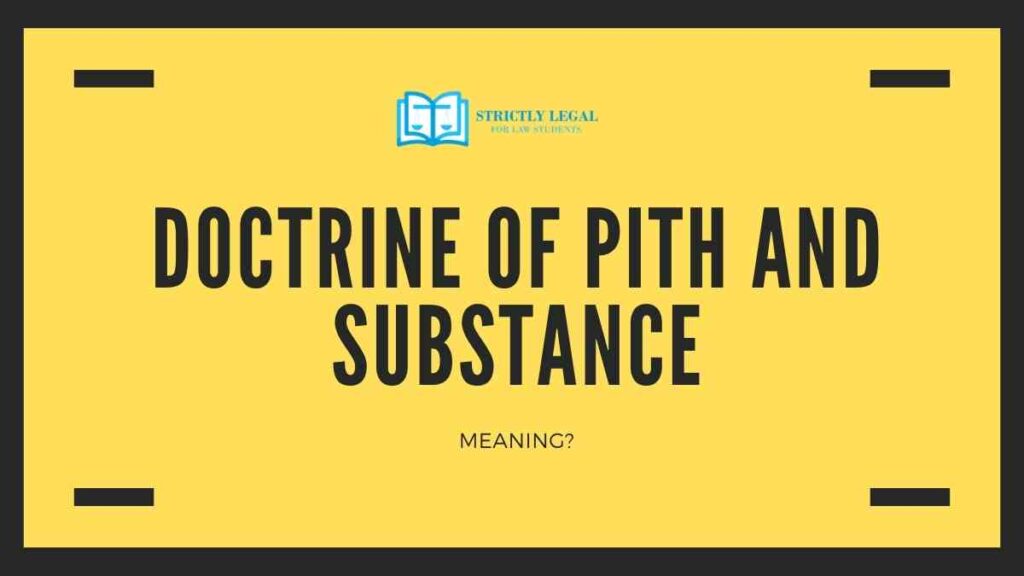The Constitution is taken to be the mother of all the laws made in the country. It is vast and lengthy in nature. However, the Constitution of India has divided the limits of legislative powers between the State and the Centre in the Seventh Schedule. Even though the sphere of the Centre and State has been well mentioned in the seventh schedule, a conflict between them often arises. In order to deal with this, the Courts of Law in India have advanced a few doctrines and the Doctrine of Pith and Substance is one among them.
Table of Contents
ORIGIN OF DOCTRINE OF PITH AND SUBSTANCE
The Doctrine of Pith and Substance was taken from a famous case in Canada in Cushing v. Dupuy. It was a landmark judgment as it paved the road for “Ancillary” and “Incidental” Encroachment which later made way to India, which is now strongly supported by Article 246 and the Seventh Schedule. The Seventh Schedule includes Union, State, and Concurrent Lists.
UNDERSTANDING THE DOCTRINE OF PITH AND SUBSTANCE
Pith refers to the Essence of Something and Substance refers to the Essential part of Something. The idea of the doctrine is waged in such occurrence to regulate which legislature has the authority to gadget such legislation. The doctrine is applied when the legislatures made legislation are questioned or challenged or trespassed by other legislation. It says-
“This doctrine says that when there is a question of regulating if a particular law relates to a particular subject the court looks to the substance of the matter. If the substance of the matter lies within one of the 3 lists, then the incidental encroachment by law on another list, does not make it invalid because they are said to be intra vires.”
ARTICLE 246 OF THE CONSTITUTION OF INDIA
The dispensation of power between the Union and the State is mentioned in Schedule VII of the Indian Constitution. The same has been consecrated in Article 246. The said article explains the powers of the Union and the State by clearly designating them into three lists I.e., Union List, State List, and Concurrent List. Please read the following to understand better:
- State List: The list in which all the states of India have the chief authority to ratify legislation. Public health, sanitation, public orders, betting and gambling, dispensaries, as well as police are a few of the matters that are covered under State list.
- Union List: The list in which the Centre of Central Government has the chief authority to ratify legislation. The Union List primarily covers the Military, foreign affairs, railways, banking and such are a few where Union can ratify legislation.
- Concurrent List: This is the list where both the State and the Union/ Centre can pass legislation. The Central law takes supersede over the State with regard to “Repugnance”. This list is primarily focused on education, population control, criminal law, forest protection, wildlife and as such.
JUDGEMENTS ON DOCTRINE ANCILLARY OR INCIDENTAL ENCROACHMENT
A. In Subramaniam Chettiar v. Muttuswami Goudan [(1941) 1 MLJ 267], one of the statutes of the Debt Relief Act, 1938; ratified by the State of Madras was later found to be “repugnant” in the Negotiable Instruments Act, 1881, one of the legislations by the Central government.Here, the court was of an opinion that the ratification that came later was at odds with the central legislation, and it cannot be furnished as void as the field of legislation was closely inter-weaved and therefore, the ratification was intra vires in nature.
- The Prafulla Kumar Banerjee v. Bank of Commerce [AIR 1947 PC 60], was one of such ancient cases keeping in mind the incidental encroachment. The State legislation’s Bengal Money Lenders Act, 1940, was questioned on the grounds of ultra vires in the legislature of Bengal. The High Court of Calcutta concluded with a verdict that the ratification was ultra vires in nature. The verdict was later challenged and was later referred to the Privy Council where the “Doctrine of Pith and Substance” was solicited and it came into a conclusion that the “substance” in the siad ratification was “lending of money” which is insured in Entry 27 of List II of Government of India Act,1935. Therefore, the Subject Matter can be very efficiently carried on by the State legislature to ratify law.
- In State of Bombay v. F.N. Balsara [AIR 1951SC 318] the chief issue was with regards to the validity of the Bombay Prohibition Act, 1949. The Honorable Court while applying the “doctrine of pith and substance” and engaging the rule of “ancillary encroachment” held the ratification that to be legally valid as it was insured under the State List and howbeit, it resulted in encroachment of the Union List, the said encroachment was secondary, and that only reason was not sufficient to be declared as null and void.
- In Zameer Ahmad Latifur Rehman Sheikh v. the State of Mohapatra and Ors (2010), the doctrine of pith and substance was largely eloquent. According to the Honorable Court, the said doctrine shall be used when the legislative power of the legislature is in doubt proportional to a specific statute. Had there been a question or challenge pertaining to the capability and capacity of the legislature, the Court of Law would have evaluated the law’s gist and content after the Act had been examined, because it is indeed censorious for the courts to examine the real character and dept of the legislation, its features, goals, impact, and scope.
CONCLUSION
The Doctrine of Pith and Substance has been highly fruitful and relevant in numerous cases where both the Centre and the State have fought for their legislative supremacy, but as we all know, the Centre has more thump in the Country than the states, the subjects that are covered in the Union List are highly essential, whereas States are only accountable or obligated to legislate those things that affect them. Even today conflicts of interest and overlaps exist because one legislation is linked to the other may it be directly or indirectly.

Law student.
Turning legal insights into engaging narratives.




